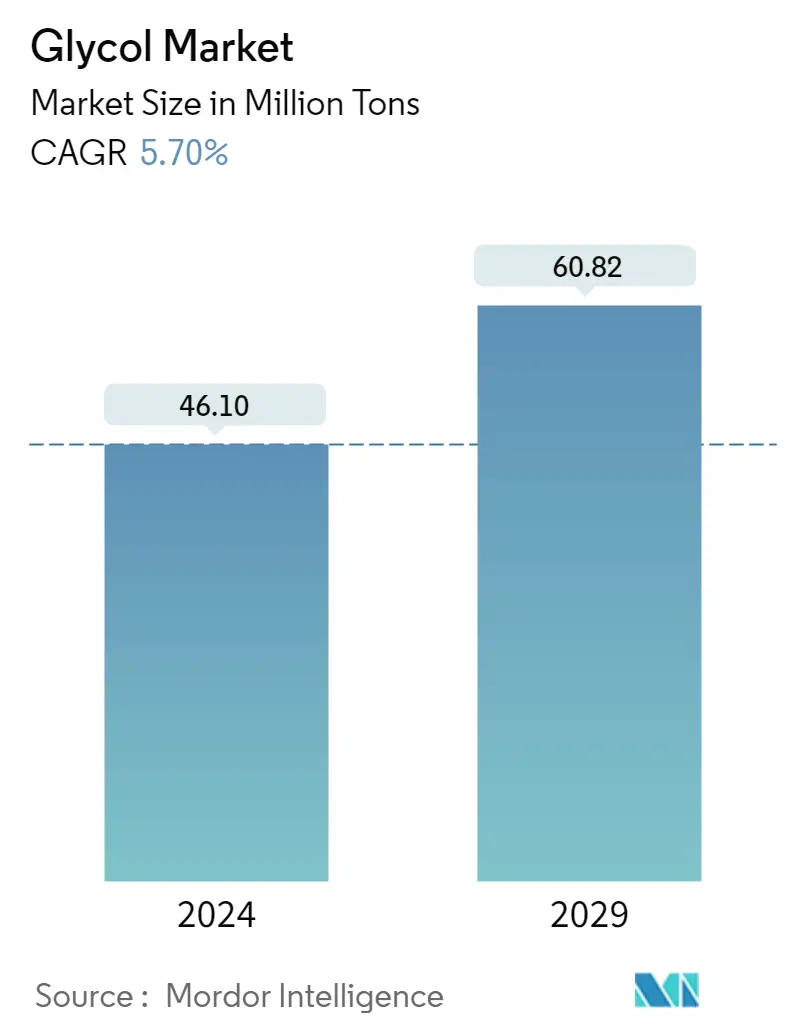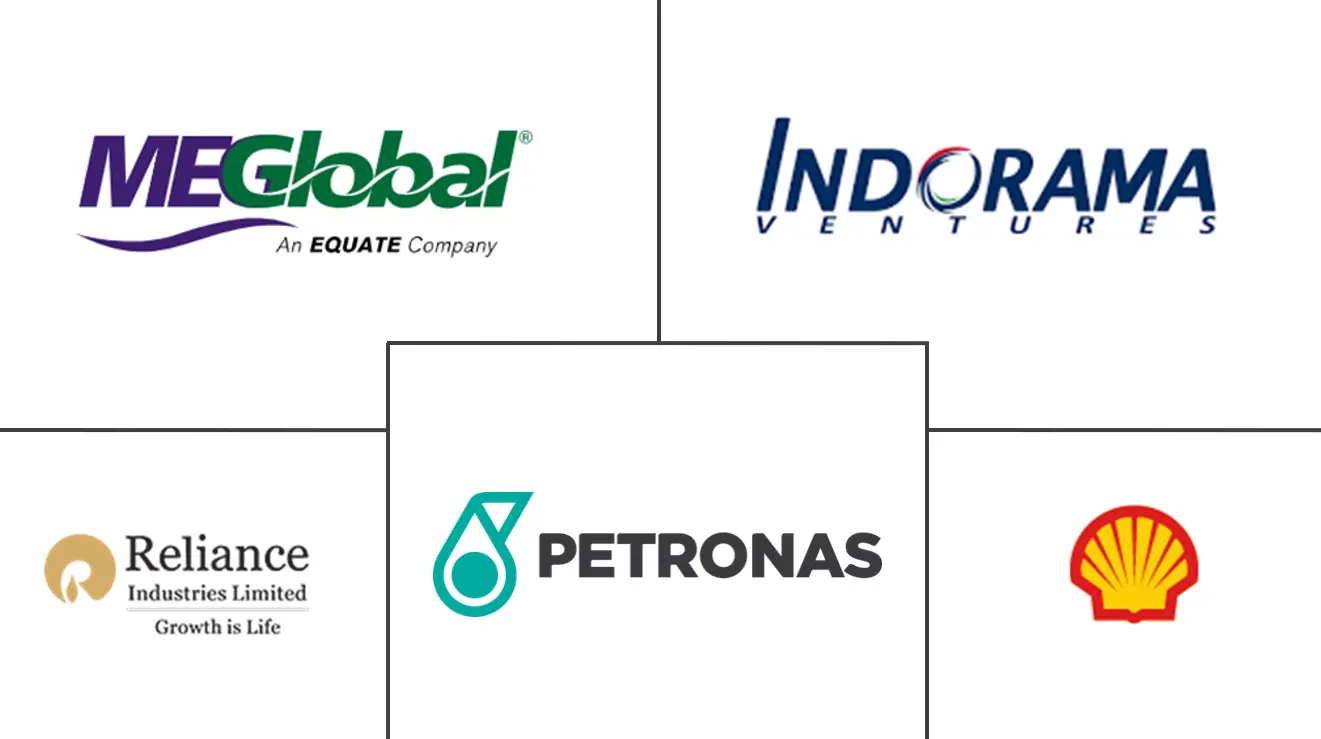Market Size of Glycol Industry

| Study Period | 2019 - 2029 |
| Base Year For Estimation | 2023 |
| CAGR (2024 - 2029) | 5.70 % |
| Fastest Growing Market | Asia Pacific |
| Largest Market | Asia Pacific |
| Market Concentration | Low |
Major Players
*Disclaimer: Major Players sorted in no particular order |
Glycol Market Analysis
The Glycol Market size is estimated at 46.10 Million tons in 2024, and is expected to reach 60.82 Million tons by 2029, growing at a CAGR of 5.70% during the forecast period (2024-2029).
.
- The COVID-19 pandemic has been a significant challenge for the glycol market due to directly affecting the manufacturer's supply chain across the globe and shutting down production facilities to minimize the risk of spreading the virus.
- Over the short term, increasing demand for polyester films and PU adhesives and increasing ethylene glycol consumption from china's textile industry are some factors stimulating the market demand.
- The toxic ethylene glycol and unfavorable conditions from the COVID-19 outbreak hinder the market growth.
- The growing popularity of bio-based glycols will likely create opportunities for the market in the coming years.
- The Asia-Pacific region represents the largest market and is expected to be the fastest-growing market over the forecast period owing to the increasing consumption from countries such as China, India, and Japan.
Glycol Industry Segmentation
Glycol is a class of chemical compounds in the alcohol family. Two hydroxyl (OH) groups are bonded to distinct carbon atoms in the glycol molecules. The word is frequently applied to the simplest member of the class, ethylene glycol. The glycol is a colorless, odorless, flammable, sweet-tasting viscous liquid. It can be toxic to humans if taken in high concentrations. The glycol market is segmented based on type, end-user industry, and geography. By type, the market is segmented into ethylene glycol, propylene glycol, and other types. The end-user industry segments the market into automotive and transportation, packaging, food and beverage, cosmetics, pharmaceuticals, textiles, and other industries. The report also covers the market sizes and forecasts for the glycol market in 15 countries across major regions. Market sizing and forecasts for each segment are based on revenue (USD million) for all the above segments.
| Type | ||||||
| ||||||
| Propylene Glycol | ||||||
| Other Types |
| End-user Industry | |
| Automotive and Transportation | |
| Packaging | |
| Food and Beverage | |
| Cosmetics | |
| Pharmaceuticals | |
| Textile | |
| Other End-user Industries |
| Geography | |||||||
| |||||||
| |||||||
| |||||||
| |||||||
|
Glycol Market Size Summary
The glycol market is poised for significant growth over the forecast period, driven by increasing demand across various industries. The market is experiencing a resurgence as the effects of the COVID-19 pandemic, which had disrupted supply chains and production, begin to wane. Key drivers of market expansion include the rising consumption of ethylene glycol in China's textile industry and the growing demand for polyester films and polyurethane adhesives. Despite challenges such as the toxicity of ethylene glycol and lingering pandemic-related issues, the market is expected to benefit from the increasing popularity of bio-based glycols. The Asia-Pacific region, particularly countries like China, India, and Japan, is anticipated to dominate the market, fueled by robust demand from sectors such as packaging, automotive, and textiles.
The glycol market's growth is further supported by its extensive application in producing polyester fibers, glycol ethers, and as an anti-freezing agent in automotive radiators. The Asia-Pacific region's burgeoning e-commerce and food processing industries, along with the expanding cosmetics market, are expected to contribute significantly to market demand. The region's packaging sector, driven by the rise in packaged food consumption and fast-moving consumer goods, also presents substantial growth opportunities. Additionally, the pharmaceutical industry's expansion in India and the increasing production of automobiles in China are likely to bolster the glycol market. The market remains fragmented, with major players like Shell PLC, MEGlobal International FZE, and Indorama Ventures Public Company Limited playing pivotal roles in shaping its trajectory.
Glycol Market Size - Table of Contents
-
1. Market Dynamics
-
1.1 Drivers
-
1.1.1 Increasing Demand for Polyester Films and PU Adhesives
-
1.1.2 Increasing Ethylene Glycol Consumption From China's Textile Industry
-
1.1.3 Other Drivers
-
-
1.2 Restraints
-
1.2.1 Toxic Nature of Ethylene Glycol
-
1.2.2 Other Restraints
-
-
1.3 Industry Value Chain Analysis
-
1.4 Porter's Five Forces Analysis
-
1.4.1 Bargaining Power of Suppliers
-
1.4.2 Bargaining power of Buyers
-
1.4.3 Threat of New Entrants
-
1.4.4 Threat of Substitute Products and Services
-
1.4.5 Degree of Competition
-
-
-
2. Market Segmentation (Market Size in Volume)
-
2.1 Type
-
2.1.1 Ethylene Glycol
-
2.1.1.1 Monoethylene Glycol (MEG)
-
2.1.1.2 Diethylene Glycol (DEG)
-
2.1.1.3 Triethylene Glycol (TEG)
-
2.1.1.4 Polyethylene Glycol (PEG)
-
-
2.1.2 Propylene Glycol
-
2.1.3 Other Types
-
-
2.2 End-user Industry
-
2.2.1 Automotive and Transportation
-
2.2.2 Packaging
-
2.2.3 Food and Beverage
-
2.2.4 Cosmetics
-
2.2.5 Pharmaceuticals
-
2.2.6 Textile
-
2.2.7 Other End-user Industries
-
-
2.3 Geography
-
2.3.1 Asia-Pacific
-
2.3.1.1 China
-
2.3.1.2 India
-
2.3.1.3 Japan
-
2.3.1.4 South Korea
-
2.3.1.5 Rest of Asia-Pacific
-
-
2.3.2 North America
-
2.3.2.1 United States
-
2.3.2.2 Canada
-
2.3.2.3 Mexico
-
-
2.3.3 Europe
-
2.3.3.1 Germany
-
2.3.3.2 United Kingdom
-
2.3.3.3 Italy
-
2.3.3.4 France
-
2.3.3.5 Rest of Europe
-
-
2.3.4 South America
-
2.3.4.1 Brazil
-
2.3.4.2 Argentina
-
2.3.4.3 Rest of South America
-
-
2.3.5 Middle-East and Africa
-
2.3.5.1 Saudi Arabia
-
2.3.5.2 South Africa
-
2.3.5.3 Rest of Middle-East and Africa
-
-
-
Glycol Market Size FAQs
How big is the Glycol Market?
The Glycol Market size is expected to reach 46.10 million tons in 2024 and grow at a CAGR of 5.70% to reach 60.82 million tons by 2029.
What is the current Glycol Market size?
In 2024, the Glycol Market size is expected to reach 46.10 million tons.

